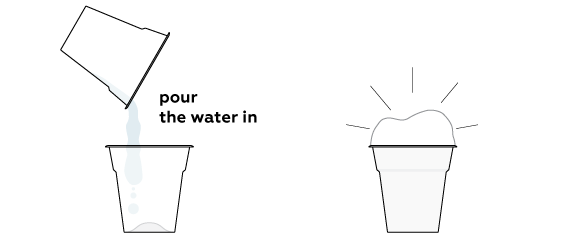Instant snow
Just add water!

Reagents
Safety
- Put on protective gloves and eyewear.
- Conduct the experiment on the tray.
- Do not allow chemicals to come into contact with the eyes or mouth.
- Keep young children, animals and those not wearing eye protection away from the experimental area.
- Store this experimental set out of reach of children under 12 years of age.
- Clean all equipment after use.
- Make sure that all containers are fully closed and properly stored after use.
- Ensure that all empty containers are disposed of properly.
- Do not use any equipment which has not been supplied with the set or recommended in the instructions for use.
- Do not replace foodstuffs in original container. Dispose of immediately.
- In case of eye contact: Wash out eye with plenty of water, holding eye open if necessary. Seek immediate medical advice.
- If swallowed: Wash out mouth with water, drink some fresh water. Do not induce vomiting. Seek immediate medical advice.
- In case of inhalation: Remove person to fresh air.
- In case of skin contact and burns: Wash affected area with plenty of water for at least 10 minutes.
- In case of doubt, seek medical advice without delay. Take the chemical and its container with you.
- In case of injury always seek medical advice.
- The incorrect use of chemicals can cause injury and damage to health. Only carry out those experiments which are listed in the instructions.
- This experimental set is for use only by children over 12 years.
- Because children’s abilities vary so much, even within age groups, supervising adults should exercise discretion as to which experiments are suitable and safe for them. The instructions should enable supervisors to assess any experiment to establish its suitability for a particular child.
- The supervising adult should discuss the warnings and safety information with the child or children before commencing the experiments. Particular attention should be paid to the safe handling of acids, alkalis and flammable liquids.
- The area surrounding the experiment should be kept clear of any obstructions and away from the storage of food. It should be well lit and ventilated and close to a water supply. A solid table with a heat resistant top should be provided
- Substances in non-reclosable packaging should be used up (completely) during the course of one experiment, i.e. after opening the package.
FAQ and troubleshooting
If you dry thoroughly your obtained artificial snow, it can be used again. However, after drying, sodium polyacrylate will not shrink to its original compact shape. Therefore, moistening it for the second time will not create the same extensive expansion effect as in the very first trial.
Yes! The snow is totally safe. However, make sure to avoid touching your face, and wash your hands right after the experiment.
Step-by-step instructions
To produce a cup of artificial snow, we will need a cup of water and some sodium polyacrylate.

Water molecules will bind to the sodium polyacrylate molecules with the help of hydrogen bonds. As a result, the sodium polyacrylate will grow in size.

To make the “snow“ blue, add 5 drops of methylene blue in step 1.
Expected result
Polyacrylate absorbs water instantly and swells much. Snow-like flakes bounce out of the plastic cup.
Disposal
Dispose of solid waste together with household garbage. Pour solutions down the sink. Wash with an excess of water.
Scientific description
What is sodium polyacrylate?
Sodium polyacrylate is a polymer. Its molecules are very long and consist of identical fragments. These fragments contain carboxyl groups that “adore” water – in other words, they are hydrophilic. This feature of polyacrylate is what guarantees the success of our experiment.
How do we obtain snow in a beaker?
Sodium polyacrylate likes absorbing water. When polymer granules absorb water, they significantly increase in volume and become visually similar to snowflakes.
Water molecules penetrate through into sodium polyacrylate granules between their molecular chains. Just like in any other aqueous solutions, each sodium cation Na+ “puts on a coat” of water molecules. Similar “coats” also appear around negatively charged polymer centers – carboxylate groups –COO–. Thus, the overall volume of the granules increases. Interestingly, water is absorbed deeply into each granule, which is why the “snowflakes” seem dry on the outside.
What will happen if we add less (more) water?
With less water, the granules would still swell but not as much, and the overall effect wouldn’t be as noticeable. However, be careful not to pour in too much water: with an excess of Н2O, the granules will stick together and form a gel – a semitransparent viscous mass similar to jelly.
Can I touch this snow?
Yes, you can, but make sure to wear protective gloves. And wash your hands after the experiment. Never, ever, eat this artificial snow!